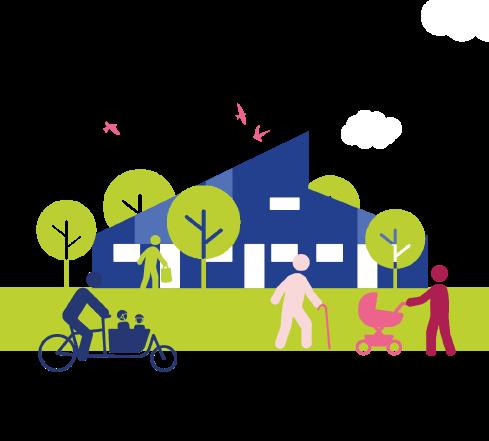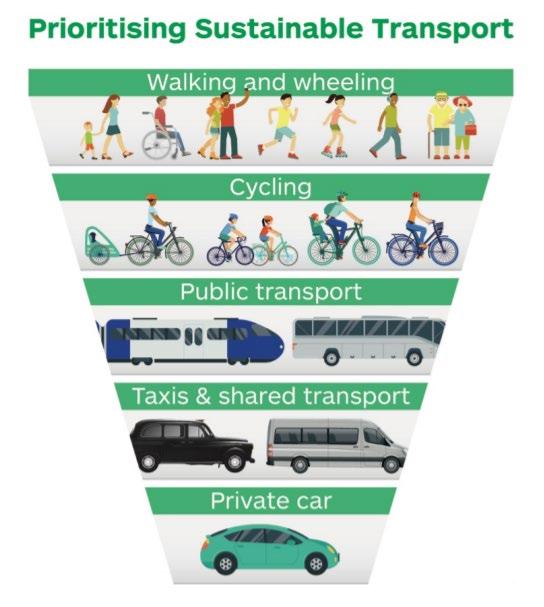

Design Objectives
Objective 1: Accessibility
Render Elderslie’s Main Road more accessible for everyone including people with disabilities, with additional mobility needs and people using wheelchairs, mobility scooters, and buggies, facilitating everyone to move around with ease, independence and confidence.








Objective 2: Public space
Improve the attractiveness of Elderslie and celebrate Elderslie’s local identity by enhancing public spaces in the village centre and improving wayfinding of existing places. Create community focussed spaces unique to Elderslie and its heritage, showcasing Elderslie as a place to live, spend time and socialise.
What would make it more attractive to spend time in Elderslie?
of respondents disagreed or strongly disagreed Main Road is accessible to people using wheelchairs, mobility scooters and buggies
‘More places to sit and socialise’
‘Reduction in littering’ 46% 31% 27% 28% 42% 41%
‘Offer links to Elderslie’s history and heritage’
‘More greenery’ ‘Improve lighting’
‘Add more colours and artwork’
56% 42%
of respondents disagreed or strongly disagreed that Main Road is accessible to disabled people and those with additional mobility needs. 63% 60% 27%
of respondents highlighted ‘Better crossing facilities’ as a preferred improvement which would make it more attractive to spend time in Elderslie.
‘Struggling to cross the road’ was the fourth most mentioned topics in the comments made. Feedback included details about the existing signalised crossing time being too short, the inadequacy of the existing crossing facilities or the lack of safe crossing points.
highlighted the poor pavement surface as a barrier to walking and wheeling.
Accessibility issues mentioned included narrow pavement, clutter, difficult gradient, excessive camber, poor surface, drainage issues and potholes.
pointed to concerns for personal safety as a barrier to walking and wheeling in Elderslie.
The risk of loitering and anti-social behaviour was a concern for placemaking proposals.
Residents expressed concerns for placemaking proposals in public spaces near their homes. Placemaking proposals should be made with significant consideration for nearby residents. Any proposals should be appropriate for their specific setting and conscious of the range of stakeholders for each spaces.
Many respondents criticised placemaking proposals or general improvement to the area by raising concerns that the Council would maintain anything new.


Design Objectives -
Objective 3: Road space
1. Formalise road space to control speeds and allow appropriate space for loading, public transport, blue badges (and potentially parking) on Main Road while preserving a two-way carriageway.
2. Increase the legibility of Glenpatrick Road junction for all users with a neutral impact on congestion.
15,000 vehicles 57%
were counted going travelling on Elderslie’s Main Road. A two-way carriageway will be preserved on Main road and proposals will aim to have a neutral impact congestion.
of vehicles were surveyed above the 30mph speed limit when entering or exiting Elderslie (east).
10 m
is the width of Main road (kerb to kerb), significantly above the required width for 30mph (5.57m). Wider roads and lane widths are correlated with higher vehicles speeds.
Main hazards on Main Road raised by vehicles users, cyclists and pedestrians:
Pedestrians intimidated by the volume and speed of traffic.
Cyclists confused by the awkward layout of the infrastructure.
Motorists highlighted hazardous behaviour at the junction.
Conflict with illegal parking was raised by all users: parking on the pavement, in the cycle lane, double parking, and in generally unsafe locations.








Objective 4: Pavement Safety
Mitigate the existing conflict between people walking, wheeling, cycling and accessing public transport along Elderslie’s Main Road and propose appropriate infrastructure following the sustainable hierarchy of transport.

The Sustainable Transport Hierarchy is a concept that places those road users most at risk in the event of a collision at the top of the hierarchy. It promotes sustainable, affordable and active modes as opposed to single occupancy car use.
69.5%
disagreed or strongly disagreed that they feel safe from traffic while cycling. Many described feeling forced to cycle on the
pavement as cycling along Main Road was perceived as too dangerous, especially for less experienced cyclists or those with children.
27%
highlighted people cycling on the pavement as a barrier to walking and wheeling. Many described
instances of conflict and using street furniture to slow down or block people cycling on the pavement.
39% of respondents highlighted ‘a safer cycle route’ as an improvement which would make it more attractive to spend time in Elderslie.

